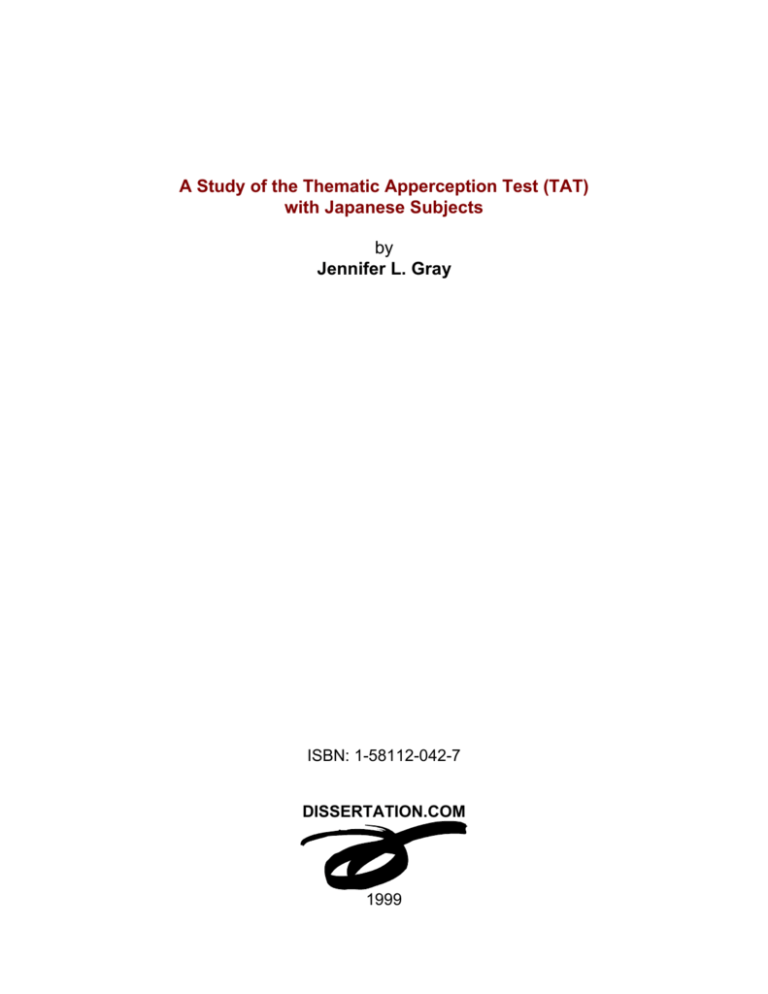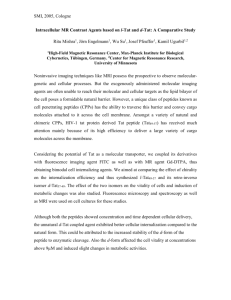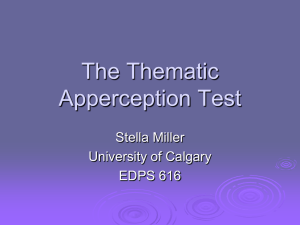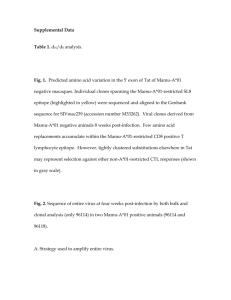
A Study of the Thematic Apperception Test (TAT)
with Japanese Subjects
by
Jennifer L. Gray
ISBN: 1-58112-042-7
DISSERTATION.COM
1999
Copyright © 1999 by Jennifer L. Gray
All Rights Reserved
ISBN: 1-58112-042-7
Dissertation.com
www.dissertation.com/library/1120427a.htm
A STUDY OF THE THEMATIC APPERCEPTION TEST (TAT)
WITH JAPANESE SUBJECTS
Dissertation
Presented to the faculty of
Southern California University for Professional Studies
Santa Ana, California
In Partial Fulfillment
of the Requirements of the Degree of
Doctor of Philosophy
By
Jennifer L. Gray
1998
ABSTRACT
A Study of the Thematic Apperception Test (TAT)
With Japanese Subjects
By
Jennifer L. Gray
Southern California University for Professional Studies
Santa Ana, California
The purpose of the study was to identify common themes on the Thematic
Apperception Test (TAT) for Japanese subjects. In addition, Japanese TAT themes were
compared with American TAT themes (Stein, 1981) for any significant differences. It was
hypothesized that significant differences in narrative themes would exist between
Japanese and American subjects.
The subjects included sixty male and female college students attending courses in
Tokyo, Japan. Subjects were enrolled in college courses during the administration of the
test and ranged in age from 18 to 27 years of age. All the participants were fluent in
English--allowing them to make responses in that language; therefore, eliminating the
errors inherent in translation. Japanese subjects were then compared with Morris I.
Stein’s original study of eighty American males conducted in 1981.
Ten of the original Murray TAT cards were used: 1, 2, 3BM, 4, 6BM, 7GF, 8BM,
10, 11 and 14. Japanese narratives were then scored using five variables for each of the
ten cards: hero gender, the incidence of death, need for achievement, dominant emotional
tone and the outcome of the story.
v
In conclusion, common TAT themes for Japanese subjects were identified for all
ten of the cards that were administered. Cards 1, 2, 4, 8BM, 10, 11 and 14 shared many
of the same themes for Japanese and American subjects. On the other hand, cards 3BM,
6BM and 7GF varied in theme content for Japanese and American subjects.
These findings will help determine the validity and reliability of the TAT as an
assessment tool for Japanese subjects, and open the door for future studies of Asian
populations in the United States as this population is underrepresented in much of the
research and literature of today.
vi
A STUDY OF THE THEMATIC APPERCEPTION TEST (TAT)
WITH JAPANESE SUBJECTS
This dissertation by Jennifer L. Gray, directed and
approved by the candidate’s committee, has been
accepted and approved by the faculty of the Southern
California University for Professional Studies in partial
fulfillment of the requirements for the degree of
DOCTOR OF PHILOSOPHY
Dissertation Committee:
vii
Dedicated to my little Lotus Prince,
Sheldon Ryan Gray,
and my loving husband,
William R. Gray II.
The two men
in my life.
viii
Such stillness—
The cries of the cicadas
sink into the rocks
Haiku poem from H. P. Varley
ix
Acknowledgments
“Acknowledgments” is the standard heading used to describe this section of a
dissertation or book. However, the heading seems too sterile or vacant to adequately
embody the deep appreciation I feel toward those who so generously shared of their
energy, time and knowledge on behalf of this project. In any event, I will try to put into
words the sentiments I do feel.
The completion of my dissertation would not have been possible without the
encouragement and support of friends and family along the way. For this reason, I would
like to thank my family for their love and selfless acceptance of my decision to follow my
dream. This project greedily devoured large amounts of my time and energy leaving only
leftover crumbs that had to then be shared amongst my spouse and three year-old toddler.
Yet, my family did not require me to apologize for this shortcoming, and my worst
obstacle was overcoming my own sense of guilt for not having more time and energy. I
would like to say thank you to the two men in my life, my husband, Bill, and our son,
Sheldon. I love you both!
I also owe a great deal of thanks to my mentor, Dr. Lynch. Her knowledge of the
Thematic Apperception Test and willingness to patiently answer my many questions was
a great assurance to me during the monotony of scoring and evaluating hundreds of
responses. She also served as an inspiring role model and friend, commiserating when I
felt discouraged or overwhelmed.
I also received a great deal of help from those who were willing to carry out
research in the library while my family and I lived overseas. For this, I would like to
thank Jeanne Smith for her selfless hours in pursuit of the journal articles and books that I
desperately needed for the literature review. In addition, Valerie MacBean also spent
x
countless hours at bookstores and libraries in pursuit of culturally relevant material that
related to my topic. I could not have done it without these two special people.
An unexpected influence was my relationship with Keiko Kodaima. Her insight
opened my eyes to the many subtle intricacies of Japanese culture.
I would also like to extend my gratitude to the committee members, Dr. Lackey,
Dr. Kirk and Dr. Linne. They all toiled over many corrections and rewrites on my behalf.
In particular, Dr. Lackey, the Committee Chair, was a calming force during moments of
exasperation and frustration.
In conclusion, I owe a debt of gratitude to my parents for their unconditional love
and support. As a new parent my life has come full circle, allowing me an intimate
understanding of the joy and struggle involved in nurturing the emotional and physical
growth of a child. I just want to say thank you Mom and Dad.
xi
TABLE OF CONTENTS
Page
ABSTRACT…………….………………………………………..v
ACKNOWLEDGMENTS……………………….……………….x
LIST OF TABLES …………………………………………….xiv
LIST OF APPENDICES ………………………………………xiv
Chapter:
I. INTRODUCTION …………………………………...17
Statement of the Problem ……………………...19
History of the TAT ……………………………..21
Highlights of Methodology …..………………..22
Definition of Terms ……………………………23
Brief Review of the Literature ………………...24
Limitations of the Study ……..………………..28
Research Findings ……………………………..28
II. REVIEW OF THE LITERATURE ………………..29
III. METHODS …………………………………….…43
Restatement of the Problem …………………...43
Research Expectations ………………………...44
Description of Research Design ……….……...44
Selection of Subjects ………………………….44
Procedures …………………………………….45
Description of Instrumentation ……………….47
xiii
Discussion of Data Processing …………………48
Methodological Assumptions and Limitations....49
IV. RESULTS ………………………………………………….53
V. DISCUSSION ………………………………………………97
References …………………………………………………….113
LIST OF APPENDICES
Appendix A
Informed Consent Form
120
Appendix B
Information Questionnaire
121
Appendix C
Instructions to the Subjects
122
Appendix D
Analysis of TAT Story Content
123
LIST OF TABLES
Table 1.
Table 2.
Table 3.
Table 4.
Table 5.
Table 6.
Table 7.
Table 8.
Table 9.
TAT Card #1 Dependent Variable
Achievement of the Hero
55
TAT Card #2 Dependent Variable
Achievement of the Hero
58
TAT Card #2 Dependent Variable
Narrative Outcome
59
TAT Card #3BM Dependent Variable
Dominant Emotional Tone
62
TAT Card #3BM Dependent Variable
Pistol Identification
63
TAT Card #3BM Dependent Variable
Death
64
TAT Card #4 Dependent Variable
Narrative Outcome
67
TAT Card #4 Dependent Variable
Dominant Emotional Tone
68
TAT Card #6BM Dependent Variable
Female-Male Relationship
71
xiv
Table 10.
Table 11.
Table 12.
Table 13.
Table 14.
Table 15.
Table 16.
Table 17.
Table 18.
Table 19
Table 20.
Table 21.
Table 22.
Table 23.
Table 24.
Table 25.
TAT Card #6BM Dependent Variable
Dominant Emotional Tone
72
TAT Card #6BM Dependent Variable
Seeking Advice
73
TAT Card #7GF Dependent Variable
Female Relationship
75
TAT Card #7GF Dependent Variable
Dominant Emotional Tone
76
TAT Card #7GF Dependent Variable
Narrative Outcome
77
TAT Card #8BM Dependent Variable
Achievement of the Hero
80
TAT Card #8BM Dependent Variable
Death
81
TAT Card #10 Dependent Variable
Dominant Emotional Tone
84
TAT Card #10 Dependent Variable
Narrative Outcome
85
TAT Card #11 Dependent Variable
Achievement of the Hero
88
TAT Card #11 Dependent Variable
Narrative Outcome
89
TAT Card #14 Dependent Variable
Death
92
TAT Card #14 Dependent Variable
Achievement of the Hero
93
TAT Card #14 Dependent Variable
Dominant Emotional Tone
94
Correlations Among Death Scales
For Japanese Subjects
104
Correlations Among Achievement
Scales For Japanese Subjects
105
xv
Table 26
Table 27
Table 28.
Correlations Among Dominant Emotion
Scales for Japanese Subjects
106
Correlations Among Narrative Outcome
For Japanese Subjects
107
Correlations Among Hero
For Japanese Subjects
108
xvi
A STUDY OF THE USE OF THE
THE THEMATIC APPERCEPTION TEST (TAT)
WITH JAPANESE SUBJECTS
CHAPTER 1
Introduction
Culture, the attitudes, beliefs and values of an ethnic group, directly affect the
events of counseling and treatment. People in the helping professions need to be aware of
the culture that the client identifies with to facilitate counseling. For this reason, it is
necessary to spend time and energy learning about the cultural background of the client.
Rollo May (1983) explains why culture is an important aspect in defining the whole
person:
…How can we know whether we are seeing the patient in his real world, the
world in which he ‘lives and moves and has his being,’ and which is for him
unique, concrete, and different from our general theories of culture? In all
probability we have never participated in his world and do not know it directly.
Yet we must know it and to some extent must be able to exist in it if we are to
have any chance of knowing the patient (p. 38).
Culture has many different definitions as a result of the different methods of
research conducted by anthropologists and social psychologists in their attempt to study
this concept. Culture has been accepted by both fields as a system of meanings (Retief,
1987). Traditionally anthropologists and sociologists have chosen ethnographic research
to define culture as the political and economical restraints that the community places on
the individual.
If anthropologists explained culture as a metaphor it would be described as
something old, new, borrowed and blue. In Japanese culture, “old” refers to the tea
ceremony or the ancient art of ikebana, flower arrangement. “Old” is what is commonly
envisioned when we think of culture. Culture also involves the “new,” personal
computers and karaoke. “Borrowed” refers to the cultural exchange that occurs when two
different groups of people meet and accept customs or products from another culture.
17
This would include the youth of Japan wearing Levi Jeans and watching MTV from
America or people from American society taking martial art classes or eating at a sushi
bar. Lastly, the color blue could be depicted as a mental state rather than a color. This
would describe the people in cultures who are not satisfied with the rules imposed by
their particular society. In any culture there are people who are unhappy with the status
quo (McCreery, 1997).
Some believe that we all share the same dynamics of the human experience and
are more alike than different, but the subtlety of cultural differences can have a strong
impact. “In looking at the psychology of a people there are many considerations,
including culture…” (Lowrey, 1983, p. 70). Therefore, client-therapist interaction is one
area of many that is greatly affected by cultural heritage.
Cross-cultural sensitivity should be reflected in the helping professions (Henkin,
1985). Counseling will either proceed smoothly or awkwardly depending on whether
there is a flow of agreement and harmony or the rocky edges of misunderstanding. Client
therapist interactions are complex enough, without adding the dimension of cultural
diversity (Corey & Corey, 1993). Yet, cultural differences need not become a stumbling
block. Instead, with some cultural perspective and a little creativity differences can
enhance the therapeutic process rather than inhibit.
Cross-cultural psychologists have conducted research for the purpose of
explaining culture in broader, quantitative terms so those conclusions could be drawn
from global comparison of cultures. For this reason, psychological assessment tools were
introduced to help explore cultural behavior. Practically, all of these tests were Western
in origin creating a cultural bias. Many of these tests were factorially based, consisting of
questions that were then grouped into scales, e.g. the personality test. The rigid structure
of contemporary psychological scales led to alternatives like the projective test (Retief,
18
1987). The Thematic Apperception Test (hereafter referred to as the TAT) is one such
projective test that allows for individual expression and cross-cultural sensitivity.
Statement of the Problem
The purpose of the present study is to identify common narrative themes on the
TAT for Japanese subjects. Second, Japanese TAT narrative themes and American TAT
narrative themes will be compared for any significant differences in content. The
comparison will be conducted using a study designed by Morris I. Stein (1981) that
identified the most common story themes for 88 American male subjects. Stein’s
findings will be compared to the responses of 60 male and female, 18-27 year old
Japanese students living in Tokyo, Japan.
This study addresses three main questions:
1. What common themes are identified on the TAT for Japanese subjects?
2. What differences in TAT theme content would be found by comparing
common themes for Japanese and American subjects?
3. Would common themes on the TAT facilitate counseling with Japanese
clients?
Subset questions related to the third question are as follows:
1. What is the dominant emotional tone of each story?
2. How common is the theme of death in the stories?
3. Is there a need for achievement in the stories? Is the character successful or
not?
4. With whom do the subjects identify and to whom do they assign the role of
hero in the stories?
5. What is the outcome of the stories? How are they concluded?
Some of these questions and themes were taken from Leopold Bellack (1993).
19
The rationale for using the TAT with Japanese subjects is to assist mental health
professionals working with Asian clients. The identification of significant cultural issues
for Japanese clients would facilitate counseling and psychotherapy. This in turn would
help alleviate premature termination, which has contributed to the problem of underuse of
mental health services by Asians (S. Sue, & Zane, 1987; Root, 1985). Stanley Sue, a
professor at the University of California and director of the Asian American Studies
Program, stated that, “…Asian Americans seriously underutilized mental health services
in comparison with their population and the relatively few clients who used services were
very severely disturbed—findings that persist even today” (Sue, 1997, p. 352). Through
study and research of Asian American populations Sue went on to demonstrate “…that
Asian Americans with moderately serious disorders avoided using services more so than
in other populations. Asian Americans come from ‘face’ cultures, so they are especially
affected by the shame and stigma attached to using mental health services.” (Sue, 1997, p.
352). Collective societies such as Japan teach conformity through the influence of the
group. A person within that group who acts against the rules of the group is ostracized
“causing a loss of face,” a feeling of humiliation that is so great that the face is turned
away in shame, hence the name. Utilizing mental health services rather than relying on
the devices and support of the family can lead to a loss of face for Asian and some nonAsian groups who have a different perspective on mental illness and pathology. This
affects whether they will seek help outside of the family or not. Although, there is stigma
associated with seeking mental health services for many Asian individuals, there is also
the notion that potential clients might not be aware of the services available to them, and
cultural unfamiliarity with clinical centers prevent them from accessing these resources in
the community. Some minority centers have tackled this problem by recruiting. This
20
kind of involvement means working with established community support centers such as
churches and community health clinics (Matthews et al., 1997).
Asian Americans “tend to terminate prematurely, and seek psychotherapy only at
the point of acute breakdown and crisis.” (Kim, 1985, p. 342). For this reason, by the
time many Asian clients make it to therapy they are in crisis and have a greater need for
services over a longer period of time. Yet, fifty percent of those clients do not return after
the initial session (Anderson, 1983). It is hoped that a tool such as the TAT could help
identify the cultural issues that prevent this group of clients from receiving the counseling
they need. Insight into the “cultural paradigm” of the client as an individual, not a
product of his/her cultural background, would enhance communication and understanding
(Ibrahim, 1985). Responses to the TAT would offer insight by forming a framework of
knowledge that would allow provision of needed services.
History of the TAT
The original brainchild for the idea of the TAT is credited to a student of
abnormal psychology from Radcliffe named Crane Brinton. Christiana D. Morgan and
Henry A. Murray first introduced the projective test in a published article in 1935. The
TAT is more closely associated with Murray than with Morgan today, although, Morgan
was responsible for the development of the picture drawing and selection (Murray, 1951).
The test was designed to elicit unconscious stimuli through the use of the
ambiguous story cards, therefore revealing the projected personality of the subject.
Projective tests unlike intelligence tests or objective tests are not looking for right or
wrong answers to test questions. Instead, the administrator of a projective test is
evaluating the individual’s response to an ambiguous situation with little or no structure.
This allows for a full range of responses from the test taker. The lack of structure and
ambiguity of this type of test can be very alarming for some subjects or allow the freedom
21
of individual expression and creativity that others enjoy. The value of the TAT lies in its
ability to reveal issues or feelings that the person taking the test might have been
unwilling or unable to bring up because the material was locked away in the unconscious.
There is a great need for culturally unbiased test instruments. Unlike objective
psychological inventories the TAT relies on the language of the client without influencing
or imposing vocabulary. The TAT’s potential is due to its use of pictures rather than
language as test stimuli. There are over 4,000 different languages spoken all over the
world which proves a tremendous stumbling block for cross-cultural psychologists trying
to design an effective testing instrument that would need to be translated into the native
language of each culture being studied. The TAT has eliminated this deterrent with its
use of picture cards not language. Language translation of a test requires lengthy
consideration in order to preserve the meaning and intention of words while allowing for
the nuances and variations of meaning that exist across cultures. “That of course, is easier
said than done; finding the exact equivalent for a single word in another language is often
impossible.” (McCrae & Costa, 1997, p. 510). For this reason, the TAT would eliminate
the need for translation of the test making it an ideal tool for the field of psychology.
Highlights of Methodology
Japanese subjects were administered the Thematic Apperception Test (TAT)
using the Leopold Bellak (1993) system. Cards 1, 2, 3BM, 4, 6BM, 7GF, 8BM, 10, 11
and 14 were selected. Projective tests have generally been used for the study of
personality and pathology, but for the purpose of this study 10 cards were administered to
each subject to identify common narrative themes for Japanese subjects. The main
narrative themes identified for Japanese subjects were compared with Stein’s study of
American narrative themes for the TAT. Studies have indicated that the TAT is a valid
instrument for measuring individual differences (Bellak et al., 1993). By using a
22
standardized set of cards for subjects and using a quantitative scoring method this study
acquired reliable data that could be further developed in future studies or compared with
existing data.
The Thematic Apperception Test was used to identify significant themes for
Japanese subjects. A study by M. Stein (1981) was used to compare common themes for
American subjects with those identified in Japanese protocol responses on the TAT.
Stein’s study is relevant to the author’s study, because it summarized the most common
themes for American subjects on the TAT. Stein’s original study is still commonly
quoted and used for the training of TAT administrators as more recent studies have not
attempted to duplicate or replace Stein’s original TAT study. The study using Japanese
subjects consisted of 60 male and female students.
Japanese subjects in the author’s study were administered a consent form,
information sheet and 10 TAT cards. The cards were administered and scored by the
writer to allow for consistency. Every effort was made to develop information about
Japanese subjects that did not stereotype or label.
Definition of Terms
The original Murray Thematic Apperception Test is referred to throughout this
paper using the acronym TAT. Revisions to the Thematic Apperception Test are referred
to specifically by a differentiating title to avoid confusion.
Freud first used the term projection to describe a defense mechanism that avoids
unwanted thoughts and feelings. Projective tests are used to describe any tool that
reflects the unconscious thoughts, wishes and desires of the subject, for example, the
Rorschach, Figure Drawing Test and the TAT.
23
Culture as defined by the author consists of a group of people who share similar
values, morals and customs. These concepts are agreed upon and upheld collectively by
the group with the intent of teaching them to future generations.
A Brief Review of the Literature
In the Diagnostic and Statistical Manual of Mental Disorders (4th ed.; DSM-IV;
American Psychiatric Association, 1994) the cultural identity of the individual is defined
by “Note[ing] the individual’s ethnic or cultural reference groups” (p. 843). Culture is
used as a reference for defining individual identity. Professionals in psychology,
therefore, need to understand cultural context in order to understand the individual.
Psychologists and the APA have a responsibility toward the minority client (Sawyer &
Senn, 1973).
“Traditional psychotherapy often requires introspection, high verbal functioning,
tolerance for ambiguity and emotional expressiveness on the part of clients”
(Stumphauzer & Davis, 1983, p. 253). Traditional Japanese are socialized to refrain from
expressing emotions directly and sharing personal details to people outside of the family.
According to Atkinson, Maruyama & Matsui (1978) Asians clearly “prefer a logical,
rational structured counseling approach over an affective, reflective, ambiguous one” (p.
81). Eastern psychotherapy, which has been studied and written about extensively by Dr.
David K. Reynolds (1989, 1991, 1992, 1993, 1995) in his books about constructive living
techniques, uses an action-based technique to cope with the problems that clients bring to
therapy. This approach is based on the work of two Japanese men: Morita and Naikan.
Japanese psychiatrist, Dr. Shoma Morita, offered very contradictory advice from Western
psychological theories, preferring an action-based approach that emphasized gratitude in
the face of adversity. These references add cultural and psychological insight about
24
Japanese clients through the study of Asian psychotherapy, and through the
administration of the Thematic Apperception Test (TAT). This writer believes that
culture specific counseling methods can be developed specifically for individual Japanese
clients using Western psychotherapy. An emphasis on Eastern psychotherapy for
Japanese clients is not needed, since the TAT allows therapists to work with specific
clients more effectively.
Other culturally related work includes John Welwood’s (1983) Eastern and
Western combination approach to psychotherapy. Welwood refers to the basic
humanness of need and vulnerability, creating neurotic anxiety, which can be overcome
through existential thought. The healing affect of the existential tradition to which
Welwood refers is based on the Eastern religious beliefs of Buddhism, which give clarity
and recognition to the Japanese psyche.
In Addition, Ron Kurtz (1990) defines and explains the Hakomi Method. This
psychotherapy is also based on eastern tradition and philosophy. This form of therapy is
less conversational and more innovative as it relies on moment to moment interpretations
and insightful analogies about Eastern tradition and philosophy as it relates to the
counseling setting. Again, with the use of the TAT projective test, counselors would be
able to tailor therapy approaches more effectively to the individual needs of the client.
People from different cultural backgrounds can benefit from therapy without the
counselor learning a whole new therapy.
This paper will focus on Asian culture, specifically Japanese. Japanese subjects
are underrepresented in societal population research, and, as a result, they remain faceless
in many cross-cultural and comparative studies conducted in the sciences (Kitano, 1973).
Many Americans hold stereotypes about the Japanese as exotic and mystical. These
stereotypes are not based on anything scientific and their influence can be very damaging
25






